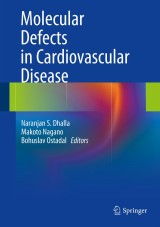Details

Molecular Defects in Cardiovascular Disease
|
CHF 130.00 |
|
| Verlag: | Springer |
| Format: | |
| Veröffentl.: | 09.08.2011 |
| ISBN/EAN: | 9781441971302 |
| Sprache: | englisch |
| Anzahl Seiten: | 382 |
Dieses eBook enthält ein Wasserzeichen.
Beschreibungen
<p>Molecular Defects in Cardiovascular Disease provides an in-depth discussion of the molecular mechanisms underlying the genesis of cardiovascular defects and the implications this has on current and emerging targeted therapeutics. Divided into three sections, this book covers the scientific foundations of our present understanding as well as the array of clinical manifestations and their treatment. The first section covers Molecular Mechanisms of Heart Disease, with discussion of the development of cardiovascular dysfunction. The remaining two sections provide a more clinical focus. The second, Cardiac Hypertrophy and Heart Failure deals with metabolic derangements, Ca<sup>2+</sup> handling, and subcellular remodeling. It illustrates the wide variety of molecular defects which may serve as targets associated with the transition from cardiac hypertrophy to advanced heart failure. The third section, Hypertension and Diabetes, provides molecular rationale for the pathogenesis of hypertension and diabetic cardiomyopathy, as well as highlighting the importance of hormones toward this end. </p><p>A necessary resource for clinicians and researchers, this book elucidates the experimental basis of the practice of cardiology. It is the culmination of our advances in the understanding of cardiovascular molecular biology and a blueprint for the efficacious use of targeted therapies.</p>
<p><b>A. Molecular Mechanisms in Heart Disease</b></p><p> </p><p>1. Calcium overloading-induced oxidative stress-mediated cellular and subcellular remodeling</p><p><i>Y. Cheema, A.U. Shahbaz, S.K. Bhattacharya, R.A. Ahokas, Y.Sun, I.C. Gerling and K.T. Weber</i></p><p><i> </i></p><p>2. Intracellular MMP-2: Role in normal and diseased hearts</p><p><i>N. Youssef and R. Schulz</i></p><p><i> </i></p><p>3. Control of the mesenchymal-derived cell phenotype by Ski and Meox2: A putative mechanism for post-developmental phenoconversion </p><p><i>R.H. Cunnington, J.T. Wigle, J.M. Douville, D.H. Freed, D. Schaafsma, S. O’Connor, S. Gupta, S.G. Rattan, A. Halayko and I.M.C. Dixon</i></p><p> </p><p>4. Elevated Na<sup>+</sup>/H<sup>+</sup> exchanger expression and its role in myocardial disease</p><p><i>L. Fliegel</i></p><p> </p><p>5. Impact of perinatal chronic hypoxia on cardiac tolerance to acute ischemia </p><p><i>B. Ostadal, I. Ostadalova, F. Kolar, I. Netuka, O. Szarszoi, </i></p><p> </p><p>6. Stem cell, microRNA and redox cycling</p><p><i>P. Mukhopadhay, N. Gurusamy and D.K. Das</i></p><p> </p><p>7. Cardiac cell therapy: Present and future</p><p><i>D.K. Singla</i></p><p> </p><p><b>B. Cardiac Hypertophy and Heart Failure</b></p><p><b> </b></p><p>8. Macroscopic and microscopic aspects of cardiac dysfunction in congestive heart failure</p><p> <i>H.E.D.J. ter Keurs</i></p><p> </p><p>9. Cardiac dysfunction and metabolism: Unravelling the molecular cross-talk</p><p><i>V. Sharma and J.H. McNeill </i></p><p> </p><p>10. Metabolic remodeling of the hypertrophied heart</p><p><i>J.M. Dai and M.F. Allard</i></p><p> </p><p>11. Mechanisms for the regulation of phospholipase C gene expression in cardiac hypertrophy</p><p><i>P.S. Tappia </i></p><p> </p><p>12. Molecular changes in fatty acid oxidation in the failing heart</p><p><i>J.S. Jaswal, W. Keung, W. Wang, J.R. Ussher and G.D. Lopaschuk</i></p><p> </p><p>13. Cardiolipin metabolism in experimental and human heart failure</p><p><i>G.M. Hatch</i></p><p> </p><p>14. Mechanisms underlying development of cardiomyocyte hypertrophy <i>via</i> Na-H exchange stimulation</p><p><i>M. Karmazyn</i></p><p><i> </i></p><p>15. The structural basis of cardiac dysfunction in human heart failure</p><p><i>S. Hein, S. Kostin and J. Schaper</i></p><p> </p><p>16. Hormonal mechanisms of cardiac remodeling in heart failure</p><p><i>A.P. Babick, V. Elimban and N.S. Dhalla</i></p><p><i> </i></p><p>17. Modulators of remodeling after myocardial infarction</p><p><i>B.I. Jugdutt</i></p><p> </p><p>18. Phosphodiesterase-5 inhibitors in protection against doxorubicin-induced cardiomyopathy</p><p><i>S. Koka and R.C. Kukreja</i></p><p> </p><p><b>C. Hypertension and Diabetes</b></p><p><b> </b></p><p>19. Molecular basis of pulmonary hypertension in left heart failure</p><p><i>B. Raj, H.S. Pillai and C.C. Kartha</i></p><p><b> </b></p><p>20. Modulation of G<sub>i</sub> protein expression in hypertension: Molecular mechanisms</p><p><i>M.B. Anand-Srivastava</i></p><p> </p><p>21. Vascular dysfunction in heart disease</p><p><i>R. Perrault and P. Zahradka</i></p><p><b> </b></p><p>22. Cellular and molecular mechanisms associated with salicylate inhibition of intimal hyperplasia balloon catheter-induced vascular injury</p><p><i>S.N. Murthy, P.J. Kadowitz and D.B. McNamara</i></p><p><b> </b></p><p>23. Involvement of growth factor receptor and non receptor protein tyrosine kinases in endothelin 1 and angiotensin II-induced signaling pathways in the cardiovascular system.</p><p><i>G. Vardatsikos and A.K. Srivastava</i></p><p><b> </b></p><p>24. Sarco/endoplasmic reticulum Ca<sup>2+</sup> pump damage by oxidative stress: Implications for Ca<sup>2+</sup> entry</p><p><i>G. Akolkar and A.K. Grover</i></p><p><i> </i></p><p>25. Obesity-hypertension: Leptin as the common link to cardiovascular and renal dysregulation</p><p><i>S. Kshatriya, H. Kozman, </i><i>D. Siddiqui, L. Bhatta, K. Liu, A. Salah, T. Ford, R. Michiel, R. Carhart and D. Villarreal</i></p><p><b> </b></p><p>26. Cardiorenal protection in diabetes mellitus</p><p><i>H. Vashistha, L.G. Meggs and A. Malhotra</i></p><p><b> </b></p><p>27. Molecular mechanisms in the pathogenesis of diabetic cardiomyopathy</p><p><i>S. Chakrabarti</i></p>
<p><i>Molecular Defects in Cardiovascular Disease</i> provides an in-depth discussion of the molecular mechanisms underlying the genesis of cardiovascular defects and the implications this has on current and emerging targeted therapeutics. Divided into three sections, this book covers the scientific foundations of our present understanding as well as the array of clinical manifestations and their treatment. The first section covers <i>Molecular Mechanisms of Heart Disease</i>, with discussion of the development of cardiovascular dysfunction. The remaining two sections provide a more clinical focus. The second, <i>Cardiac Hypertrophy and Heart Failure </i>deals with metabolic derangements, Ca<sup>2+</sup> handling, and subcellular remodeling. It illustrates the wide variety of molecular defects which may serve as targets associated with the transition from cardiac hypertrophy to advanced heart failure. The third section, <i>Hypertension and Diabetes</i>, provides molecular rationale for the pathogenesis of hypertension and diabetic cardiomyopathy, as well as highlighting the importance of hormones toward this end. </p><p> </p>A necessary resource for clinicians and researchers, this book elucidates the experimental basis of the practice of cardiology. It is the culmination of our advances in the understanding of cardiovascular molecular biology and a blueprint for the efficacious use of targeted therapies.
<p>Outlines novel targets for the treatment of cardiovascular diseases</p><p>Elucidates the role of biochemical insults and metabolic derangements in altering gene expression</p><p>Provides an understanding of the molecular genesis of cardiovascular dysfunction</p>
Diese Produkte könnten Sie auch interessieren:

Razum prestupnika i logika prestupleniya. O psihiatrii, sudah i seriynyh ubiytsah

von: Shohom Das, Dmitry Chepusov

CHF 7.00

















